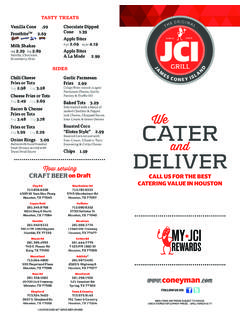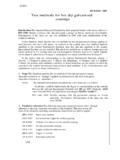Transcription of IMPORTANT Liability Disclaimer - amico-lath.com
1 To Our Valued Customers:The following documents are the Material Safety Data Sheets (MSDS's) of our various productlines for your reference. They have been prepared with information from our suppliers to complywith the Federal Hazard Communication Standard, 29 CFR The MSDS containsimportant safety, health and regulatory information that is IMPORTANT to you, your employees andcustomers who are exposed to these materials. In addition, some of the components may be subject to the reporting requirements of Section313, Title III of the Superfund Amendments and Reauthorization Act of 1986 (SARA), 40 CFRPart 372, as well as to the Comprehensive Environmental Response, Conservation and LiabilityAct of 1980 (CERCLA), 40 CFR Part 302.
2 If you are unsure as to your reporting requirements,or need more information, call the USEPA SARA Hotline: (800) 424-9346, or the EmergencyPlanning and Community Right-to-Know Act Hotline: (800) MSDS is supplied to provide safety, health and environmental information only and must not be used for material contact your sales person or call us directly if you require further Fayette AvenueBirmingham, Alabama 35208be correct as it was obtained from sources we believe are reliable. However, no representations,205-787-2611 IMPORTANTL iability DisclaimerThe information contained in the referenced Material Safety Data Sheet (MSDS) is believed toSincerely,AMICO guarantees or warranties of any kind are made as to its accuracy, suitability for particularapplications, hazards connected with the use of the material, variations in methods, conditionsand equipment used to store, handle, or process the material and hazards connected with theuse of the material are solely the responsibility of the user and remain at his/her sole with all applicable federal, state, and local laws and regulations remains the responsibilityof the user, and the user has the responsibility to provide a safe work place to examine all aspectsof its operation and to determine if or where precautions.
3 In addition to those described herein, are Name:Galvanized (Hot dipped ) Sheet - Carbon Steel;Products:Galvanized LathEmergency Phone Number:CHEMTREC (800) 424-9300 TiLathBase Metal*Notes: *Percent weight of metallic coating is a percent of the total product. Galvanized sheet surfaces may be chemically treated, generally at the customer's specification, with trace amounts of chromate solution(approximately 1 to 2 mg/ft per side or < of total product weight) to prevent humid storage stain, and/or phosphate solutions (<300 mg/ft or < ) to enhance paint adherence and formability. Surface may also be treated with small amounts (< ) of corrosion-inhibitingoil.
4 All commercial steel products may contain small amounts of various elements in addition to those specified. These small quantities (less ) may exist as intentional additions, or as "trace" or "residual" elements that generally originate in the raw materials used. These elementsmay include: aluminum, antimony, arsenic, boron, cadmium, calcium, chromium, cobalt, columbium, copper, lead, molybdenum, nickel, silicon,tin, titanium, vanadium, and zirconiumGalvanized (Hot dipped ) Sheet - Carbon Steel Rev. 05/02 OSHA Permissible Exposure Limits (PELs) are 8-hour TWA (time-weighted average) concentrations unless otherwise noted.
5 A ("C") design-Exposure Limit (STEL) is defined as a 15-minute exposure, which should not be exceeded at any time during a workday. Threshold Limit Values (TLV) established by the American Conference of Governmental Industrial Hygienists (ACGIH) are 8-hour TWA concentrations unless otherwise noted. PNOR (Particulates Not Otherwise Regulated). All inert or nuisance dusts, whether mineral, inorganic, or organic, not listed specifically by5 mg/m - Fume 5 mg/m - Fume mg/m 10 mg/m - Iron oxide mg/m mg/m 5 mg/m - Iron oxide dust and mg/m mg/m - Welding fume15 mg/m - Total dust 10 mg/m - Metal dust 5 mg/m - Respirable - mg/m - Dusts & mists (as Cu)PhosphorusSilicon10 mg/m - Inhalable fraction (PNOS) 10 mg/m 15 mg/m - Total dust (PNOR)
6 15 mg/m - Total dust mg/m - Fume mg/m - Calcium oxide5 mg/m - Respirable fraction (PNOR)10 mg/m - Inhalable fraction (PNOS) 3 mg/m - Respirable fraction (PNOS)15 mg/m - Total dust (PNOR) 10 mg/m - Iron oxide fumeACGIH TLV OSHA PEL 5 mg/m - Calcium oxideIngredient NameCAS NumberPercentage by mg/m - Iron oxide dust and fumeIron7439-89-6> SAFETY DATA SHEET3245 Fayette Avenue Birmingham, AL 35208 SECTION I. MATERIAL IDENTIFICATIONSECTION II. COMPOSITION/INFORMATION ON INGREDIENTSA lloying mg/m - Respirable fraction (PNOS)5 mg/m - Respirable fraction5 mg/m (C) - Fume & Mn mg/m mg/m - Fume (as Cu) 1 mg/m - Dusts & mists (as Cu)5 mg/m - Respirable fraction (PNOR)3 mg/m - Respirable fraction (PNOS)5 mg/m - Respirable fraction (PNOR)10 mg/m - Inhalable fraction (PNOS) 15 mg/m - Total dust (PNOR) 15 mg/m - Total dust 5 mg/m - Respirable fraction10 mg/m - Fume (STEL) 10 mg/m - Dust1 Creation Date: 09/01/85 Revision Date.
7 07/31/13substance name are covered by the PNOR limit which is the same as the inert or nuisance dust limit of 15 mg/m for total dust and 5 mg/m forthe respirable fraction. Inhalable fraction. The concentration of inhalable particulate for the application of this TLV is to be determined from the fraction passing a size-selector with the characteristics defined in the ACGIH TLVs and BEIs Appendix D, paragraph A. PNOS (Particulates Not Otherwise Specified). Particulates identified under the PNOS heading are "nuisance dusts" containing no asbestos and <1% crystalline silica. A TWA-TLV of 10 mg/m for inhalable particulate and 3 mg/m for respirable particulate has been recommended.
8 Respirable fraction. The concentration of respirable dust for the application of this limit is to be determined from the fraction passing a size-selector with the characteristics defined in the ACGIH TLVs and BEIs Appendix D, paragraph C. The 8-hour PEL is 50 ug/m . If an employee is exposed to lead for more than 8-hours in any work day, the PEL, as a TWA for that day, shall be reduced according to the following formula: Maximum permissible limit (in ug/m ) = 400 divided by hours worked in that day. The Action Level is 30 ug/m averaged over an 8-hour formed solid metal product poses little or no immediate health or fire hazard. When product is subjected to welding, burning, melting, sawing, brazing, grinding, or other similar processes, potentially hazardous airborne particulate and fumes may be generated.
9 Avoid inhalation of metal dusts and fumes. Operations having the potential to generate airborneparticulates should be performed in well ventilated areas and, if appropriate, respiratory protection and other personal protective equipment should be used. Iron or steel foreign bodies imbedded in the cornea of the eye may produce rust stains unless removed fairly promptly. Primary Entry Routes: Inhalation and skin, if coated. Steel products in the natural state do not present an inhalation, ingestion or contact hazard. However, operations such as burning, welding, sawing, brazing, machining and grinding may result in the following effects if exposures exceed recommended limits as listed in Section Organs: Respiratory Effects: Inhalation: Excessive exposure to high concentrations of dust may cause irritation to the eyes, skin and mucousmembranes of the upper respiratory tract.
10 Excessive inhalation of fumes of freshly formed metal oxide particles sized below microns and usually between - microns from many metals can produce an acute reaction known as "metal fume fever". Symptoms consist of chills and fever (very similar to and easily confused with flu symptoms), metallic taste in the mouth, dryness and irritation of the throat followed by weakness and muscle pain. The symptoms come on in a few hours after excessive exposures and usually last from 12 to 48 hours. Long-term effects from metal fume fever have not been noted. Freshly formed oxide fumes of manganese, copper and zinc have been associated with causing metal fume fever.











